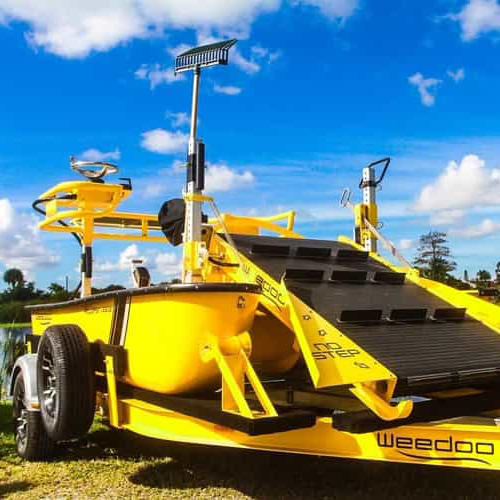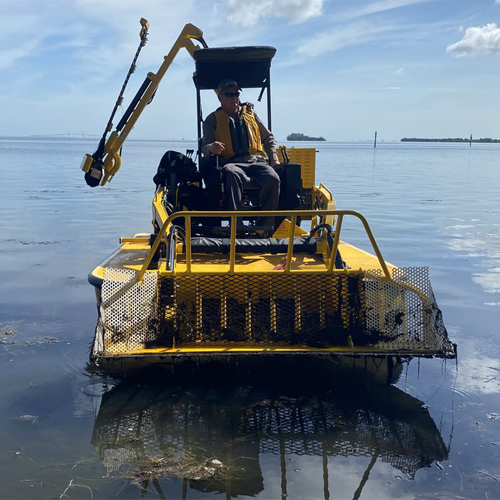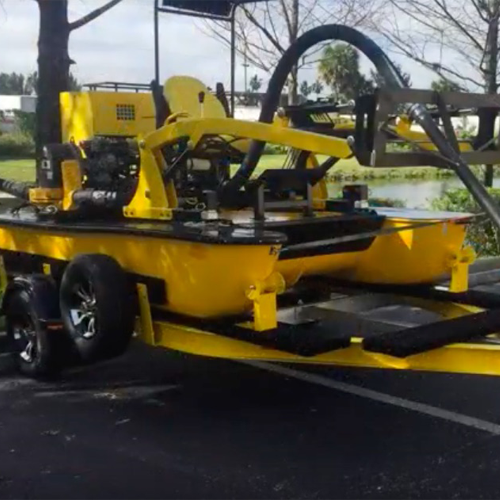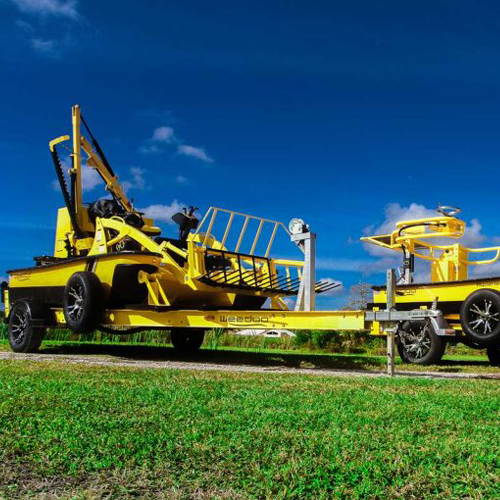Commentary on the Article “Technology and Improved Mechanical Control” / Fall 2012 Issue Aquatics / A Publication of the Florida Plant Management Society
Commentary on a study that dispels the dogma of mechanical harvesting of Hydrilla being too expensive and too damaging to fish populations.
Author: Dr. Bruce A. Richards Chief Scientist Weedoo Shoreline Workboats, Inc.West Palm Beach, FloridaApril 12, 2016

It was encouraging to read a summary study on mechanical harvesting in an article I found from the Fall 2012 Issue of Aquatics. This article reviewed the feasibility of mechanical harvesting in early 2012 compared to mechanical harvesting from a 1979 Army Corp of Engineers (ACE) study on Hydrilla growth in Orange Lake, Florida. Here are my observations from this report:
Economics: The 1979 ACE report estimated that aquatic harvesting would cost $455/acre only harvesting4.3 acres per day, which adjusted for inflation would be $1486/acre today. Actually, with WeedooINC many of our owner-operators are able to harvest up to 10 acres/day charging$1500to$2000per day. That equates to about$150 to $200/acre in today’s dollars assuming an eight-hour workday. Current costs for some aquatic herbicide applications are $600/acre or more. Just from the economics, aquatic harvesting is worth consideration from this study.
Biological Considerations: In the 1979 ACE study harvesting Hydrilla required cutting every two weeks since the plant was growing an estimated 1”per day. This meant that harvesting was needed six or more times per year. Fish bycatch was estimated at 27,000 fish/acre, which represented 1/3rd of the total number of fish for Orange Lake. Holy Mackerel! It’s no wonder these results would certainly steer the water manager away from harvesting. The efficiency of harvesting, longevity of control and bycatch would certainly become a concern.
So, it’s not a surprise Florida went the chemical route inthe1980s. In the 1990s Fluridone resistant Hydrilla proliferated in Florida, giving harvesting a second look. Using the larger 70’harvesting vessels the author (Haller 1996) found some surprising results
So, it’s not a surprise Florida went the chemical route inthe1980s. In the 1990s Fluridone resistant Hydrilla proliferated in Florida, giving harvesting a second look. Using the larger 70’harvesting vessels the author (Haller 1996) found some surprising results
- Improvement to one acre of harvesting per hour
- Reduced rates of pondweed re-growth was noted
- Off shore bycatch was greater than near shore with less than 1% of bycatch in 1996 study compared to 1979 study
- Timing of the harvest was an important key to managing Hydrilla growth *Cutting Hydrilla deeper reduced harvesting frequency. If you cut down 5’below the surface, this would provide 2 months of Hydrilla control.Timing of the harvest was an important key to managing Hydrilla growth *Cutting Hydrilla deeper reduced harvesting frequency. If you cut down 5’below the surface, this would provide 2 months of Hydrilla control.
Note the author’s summary statement:
“The timing of the harvest, the depth of the water, the height of the Hydrilla below the surface likely contributed to the much lower acceptable fish impacts. Certainly additional improvements can be made to improve efficacy, but this study should dispel the dogma that mechanical harvesting of Hydrilla is too expensive and too damaging to fish populations.” In recent years, Florida has successfully treated Hydrilla using mostly chemical herbicides. This aquarium released aquatic plant is now moving northward. Fluridone resistant Hydrilla has emerged like antibiotic resistant bacteria in humans. Perhaps there are lessons learned from looking back to the 1979 study and what appeared to be the Army Corp of Engineers summarily dismissing aquatic harvesting as costly, inefficient and destructive to bycatch. We’ve all learned a lot since then.
“The timing of the harvest, the depth of the water, the height of the Hydrilla below the surface likely contributed to the much lower acceptable fish impacts. Certainly additional improvements can be made to improve efficacy, but this study should dispel the dogma that mechanical harvesting of Hydrilla is too expensive and too damaging to fish populations.” In recent years, Florida has successfully treated Hydrilla using mostly chemical herbicides. This aquarium released aquatic plant is now moving northward. Fluridone resistant Hydrilla has emerged like antibiotic resistant bacteria in humans. Perhaps there are lessons learned from looking back to the 1979 study and what appeared to be the Army Corp of Engineers summarily dismissing aquatic harvesting as costly, inefficient and destructive to bycatch. We’ve all learned a lot since then.
Alternatives to Chemicals: Our medical culture is quick to reach for the pharmaceutical approach. Pesticides in the environment and medications in our body provide a rapid response. Sometimes our reliance on chemical treatments comes at a cost to biological ecosystems. The authors (Haller and Jones) are commended for taking an objective and fair look at aquatic harvesting in Florida.
Take a look at the facts: Using technology like WeedooINC provides a sustainable, environmental friendly and economically feasible approach to removing macroalgae and aquatic invasive plants.



